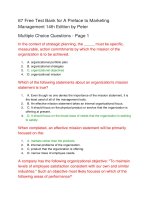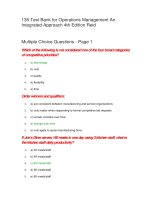Test bank for maternity nursing an introductory text 11th edition by leifer
Bạn đang xem bản rút gọn của tài liệu. Xem và tải ngay bản đầy đủ của tài liệu tại đây (69.16 KB, 8 trang )
buy this full document at
Leifer: Maternity Nursing: An Introductory Text, 11th Edition
Chapter 01: Contemporary Maternity Care, Family, and Cultural Considerations
Test Bank
MULTIPLE CHOICE
1. A disadvantage of freestanding birth centers is that:
a. Many lack adequate technology and medical care to deal with complications.
b. They are often more expensive than hospital-based delivery settings.
c. The presence of family members increases the risk of postpartum infection.
d. Mothers are expected to leave freestanding birthing centers shortly after delivery.
ANS: A
Many of these centers do not have the technology or medical care readily available to assist in
an emergency.
DIF: Cognitive Level: Knowledge
TOP: Birth Settings
MSC: NCLEX: N/A
REF: 2
OBJ: 2
KEY: Nursing Process Step: N/A
2. The role of the community-based nurse has evolved to emphasize:
a. Managing care to cure health problems once they have been identified
b. Participating in the activities of a team of interdisciplinary health care providers
c. Providing direct care to patients
d. Planning patient care
ANS: B
The nurse must work with the interdisciplinary health care team to identify needs within the
community and create cost-effective approaches to comprehensive preventive and therapeutic
care. While providing and planning patient care is still important, the evolving role of the
community-health nurse now requires additional skills, such as creativity, problem solving,
coordination of multidisciplinary caregivers, case management, assessment, and referral.
DIF: Cognitive Level: Comprehension
REF: 4
OBJ: 6
TOP: Community-Based Nursing
KEY: Nursing Process Step: N/A
MSC: NCLEX: Health Promotion and Maintenance
3. Symbols, actions, gestures, facial expressions, and body positions are examples of:
a. Subtle communication
b. Listening
c. Nonverbal language
d. Observation
ANS: C
These are all examples of nonverbal language—means of communicating a message without
words.
DIF: Cognitive Level: Knowledge
REF: 8
OBJ: 11
buy this full document at
Full file at />TOP: Communication
MSC: NCLEX: N/A
KEY: Nursing Process Step: N/A
4. A health care system in which physicians and hospitals contract with insurers to provide
service at a discounted rate to members is a:
a. Health maintenance organization
b. Diagnosis-related group
c. Preferred provider organization
d. Federally managed insurance plan
ANS: C
A preferred provider organization (PPO) is a network of providers who agree to provide care
at a discount to individuals covered under the plan.
DIF: Cognitive Level: Knowledge
TOP: Managed Care
MSC: NCLEX: N/A
REF: 3
OBJ: 7
KEY: Nursing Process Step: N/A
5. Unlike a nursing care plan, a clinical pathway:
a. Includes nursing interventions
b. Presents criteria for hospital discharge
c. Spells out the patient progress expected each day
d. Includes nursing care only
ANS: C
Clinical pathways guide the daily care and expected progress of the patient. They reflect a
multidisciplinary focus and are based on research and standards of care. The nursing care plan
applies patient and nursing responses based on structured problem-solving approaches to
clinical problems.
DIF: Cognitive Level: Comprehension
TOP: Clinical Pathways
MSC: NCLEX: N/A
REF: 3-4
OBJ: 5
KEY: Nursing Process Step: N/A
6. The nurse is working with a pregnant woman who is employed at minimum wage. She has
three small children. Her mother cares for the children so she can work, but she says she
cannot afford to feed her children properly. The nurse should refer her to the:
a. Women, Infants, and Children program
b. National Institutes of Health
c. Local Medicare office
d. Job Corps
ANS: A
The woman’s immediate need is to feed herself and her children. The Women, Infants, and
Children (WIC) program provides supplemental food and education for the indigent.
DIF:
TOP:
KEY:
MSC:
Cognitive Level: Application
REF: 4
Specific Government Influences in Maternal/Infant Care
Nursing Process Step: Implementation
NCLEX: Health Promotion and Maintenance
OBJ: 7
Copyright © 2012, 2008 by Saunders, an imprint of Elsevier Inc.
Full file at />7. The patient asks the nurse why the birth certificate is important. The nurse explains that
statistics gathered from the birth certificate are used to:
a. Supplement data obtained in the U.S. census.
b. Track maternal mortality rates.
c. Guide the allocation of resources for mothers and infants.
d. Document outcomes of all pregnancies in the United States.
ANS: C
Birth certificates document live births and provide information about maternal and infant
health that is used in determining the allocation of health resources.
DIF: Cognitive Level: Comprehension
REF: 5
TOP: Statistics Important to Maternal/Infant Care
MSC: NCLEX: N/A
OBJ: 8
KEY: Nursing Process Step: N/A
8. The effect of standards of care on nursing is to:
a. Establish minimum criteria for competent nursing care.
b. Allow other professions to determine what constitutes nursing care.
c. Encourage lawsuits by presenting unrealistic expectations of nurses.
d. Specify what action a nurse with a master’s degree would take in a given situation.
ANS: A
Standards of care provide a minimum standard by which to judge the quality of care provided.
They are based on expectations of what a reasonable nurse with similar education and
experience would do in like circumstances. Therefore, expectations of an LPN/LVN and an
MSN would differ. The standards come from professional nursing organizations.
DIF: Cognitive Level: Knowledge
TOP: Standards of Care
MSC: NCLEX: N/A
REF: 5
OBJ: 9
KEY: Nursing Process Step: N/A
9. The nurse’s employer wants LPNs/LVNs to begin doing some procedures that are now being
performed by RNs only. Which of the following is the best source of information about taking
on these new tasks?
a. The National League for Nursing
b. The National Federation of Licensed Practical Nurses
c. The American Nurses Association Division of Practice
d. The Joint Commission
ANS: B
The National Federation of Licensed Practical Nurses (NFLPN) describes the role of
LPNs/LVNs in clinical practice today. In addition, nursing actions must be in accordance with
the nurse practice acts of the state in which the nurse is practicing.
DIF: Cognitive Level: Knowledge
TOP: Standards of Care
MSC: NCLEX: N/A
REF: 7
OBJ: 10
KEY: Nursing Process Step: N/A
Copyright © 2012, 2008 by Saunders, an imprint of Elsevier Inc.
Full file at />10. The nurse is interviewing a returning patient in the prenatal clinic. The nurse has recorded the
patient’s name, age, month of gestation, number and ages of children, and chief complaint
(backache). This illustrates which step of the nursing process?
a. Assessment
b. Planning
c. Implementation
d. Evaluation
ANS: A
Assessment includes the collection of objective and subjective patient data.
DIF: Cognitive Level: Knowledge
TOP: Nursing Process
MSC: NCLEX: N/A
REF: 9
OBJ: 14
KEY: Nursing Process Step: Assessment
11. In the prenatal clinic, a patient who is in her eighth month of pregnancy complains of
backaches. Further questioning reveals that the pain is in the lower back region and is worse at
the end of the day. The patient has no discomfort on voiding. She is working part-time as a file
clerk. She has children ages 2 and 5 years. The nurse thinks the patient’s backaches are
probably due to improper bending and lifting. This attempt to determine the nature of the
patient’s complaint and possible causes reflects which step of the nursing process?
a. Assessment
b. Diagnosis
c. Planning
d. Evaluation
ANS: B
To make a nursing diagnosis, the nurse pulls together related data that pinpoint a problem and
help reveal contributing factors.
DIF: Cognitive Level: Comprehension
TOP: Nursing Process
MSC: NCLEX: N/A
REF: 9
OBJ: 14
KEY: Nursing Process Step: Diagnosis
12. A patient in the prenatal clinic has backaches related to improper lifting and bending. The
nurse demonstrates good body mechanics and explains how they can reduce back strain. This
illustrates which step of the nursing process?
a. Assessment
b. Diagnosis
c. Planning
d. Implementation
ANS: D
In the implementation step, the nurse carries out interventions to address the nursing
diagnosis.
DIF: Cognitive Level: Application
REF: 9
OBJ: 14
TOP: Nursing Process
KEY: Nursing Process Step: Implementation
MSC: NCLEX: Health Promotion and Maintenance
Copyright © 2012, 2008 by Saunders, an imprint of Elsevier Inc.
Full file at />13. The nurse has demonstrated good body mechanics to a prenatal patient. She then asks the
patient to practice by picking up her 2-year-old. This illustrates which step of the nursing
process?
a. Assessment
b. Planning
c. Implementation
d. Evaluation
ANS: D
By having her return the demonstration, you are evaluating whether she understands and can
perform the activities as advised.
DIF: Cognitive Level: Application
REF: 9
OBJ: 14
TOP: Nursing Process
KEY: Nursing Process Step: Evaluation
MSC: NCLEX: Health Promotion and Maintenance
14. The nurse who understands cultural differences and adapts clinical practice to a patient’s
culture is said to have:
a. Cultural competence
b. Empathy
c. Open-mindedness
d. Compassion
ANS: A
Cultural competence requires knowledge and appreciation of other cultures that permit
adaptation of nursing care to accommodate the patient’s cultural beliefs and practices.
DIF: Cognitive Level: Comprehension
REF: 11
TOP: Culture
KEY: Nursing Process Step: N/A
OBJ: 16
MSC: NCLEX: N/A
15. The family type in which several families live together and share responsibilities is called:
a. Nuclear
b. Blended
c. Cohabiting
d. Communal
ANS: D
This definition describes the communal family.
DIF: Cognitive Level: Knowledge
TOP: Family Types
MSC: NCLEX: N/A
REF: 14 | Box 1-6 OBJ: 17
KEY: Nursing Process Step: N/A
16. The nurse’s interview with a new prenatal patient reveals that the patient is taking herbs that
she believes will promote her baby’s health. The nurse’s most appropriate response is:
a. “That’s a great idea! Herbs are natural products and cannot be harmful.”
b. “It’s your choice if you want to take herbs, but the doctor won’t like it.”
c. “It is important to let your doctor know everything you are taking.”
d. “That is nonsense and could actually harm you or your baby.”
Copyright © 2012, 2008 by Saunders, an imprint of Elsevier Inc.
Full file at />ANS: C
Nurses should not advocate or discourage use of herbal and folk remedies. However, health
care providers need to know what the patient is taking because herbs and other remedies may
affect traditional medicines. Also, the patient may not know whether the herbs are potentially
harmful to her or her fetus.
DIF: Cognitive Level: Application
REF: 14
OBJ: 19
TOP: Complementary and Alternative Therapies
KEY: Nursing Process Step: Assessment MSC: NCLEX: Physiologic Integrity
17. A family is defined as:
a. At least one parent in a household with one or more children
b. Two or more individuals who share bonds and emotional closeness and who
consider themselves a family
c. A husband and wife with at least one child
d. Several individuals related by marriage or blood who make up a single household
and share financial resources
ANS: B
The U.S. Census Bureau definition of family (two or more people who reside together and
who are related by blood, marriage, or adoption) is useful for statistical purposes, but is
limited when assessing a family for health purposes. A broader definition considers a family
as “two or more people who live in the same household, share a common emotional bond, and
perform certain interrelated social tasks.”
DIF: Cognitive Level: Comprehension
TOP: Family Types
MSC: NCLEX: N/A
REF: 13
OBJ: 17
KEY: Nursing Process Step: N/A
18. The patient asks the nurse, “Why do I have to sign this form? What good does it do me?” The
nurse responds by explaining that the form outlines the Health Insurance Portability and
Accountability Act of 1996 (HIPAA), and that HIPAA was enacted primarily to:
a. Protect patient confidentiality and privacy.
b. Render insurance companies accountable for payment for services.
c. Ensure that a person could move his or her health insurance from one place of
employment to another.
d. Prevent cultural, ethnic, or gender-based discrimination against patients.
ANS: A
Patient privacy is protected by federal law and regulated by accrediting agencies. The Privacy
Act of 1974 and HIPAA require a patient’s consent before any identifying information (name,
Social Security number, diagnosis) is disclosed from the medical records.
DIF: Cognitive Level: Comprehension
TOP: Patient Privacy and HIPAA Rights
MSC: NCLEX: N/A
REF: 8
OBJ: 13
KEY: Nursing Process Step: N/A
19. The number of deaths of infants younger than 1 year per 1000 live births is known as the
_____ rate.
Copyright © 2012, 2008 by Saunders, an imprint of Elsevier Inc.
Full file at />a. Birth
b. Infant mortality
c. Fetal mortality
d. Neonatal mortality
ANS: B
Vital statistics depict the status of health of the nation’s women and children and help the
government allocate resources to meet identified needs.
DIF: Cognitive Level: Knowledge
REF: 7 | Box 1-2
TOP: Statistics Important to Maternal/Newborn Care
MSC: NCLEX: N/A
OBJ: 8
KEY: Nursing Process Step: N/A
20. “The newborn will maintain a patent airway as evidenced by regular, unlabored respirations
with no cyanosis or pallor.” The nurse recognizes this to be which step of the nursing process?
a. Assessment
b. Planning
c. Implementation
d. Evaluation
ANS: B
During the planning phase of the nursing process, comprehensive nursing care is planned and
stated as specific, individualized, measurable goals.
DIF: Cognitive Level: Application
TOP: Nursing Process
MSC: NCLEX: N/A
REF: 9
OBJ: 14
KEY: Nursing Process Step: Planning
21. The nurse is receiving the shift report on a postpartum patient of Latin American descent.
Which response(s) would not be expected and warrant(s) further discussion?
a. “Her grandmother will be assisting with her bath.”
b. “She will start breastfeeding in a few more days.”
c. “Keep the window open so the baby can get some cool, fresh air.”
d. “The baby will not be circumcised.”
ANS: C
The Latin American culture believes that currents of air are dangerous and the newborn
should be kept warm. The grandmother cares for the mother during recovery, breastfeeding is
usually started after the third postpartum day, and the male newborn is often uncircumcised.
DIF: Cognitive Level: Comprehension
OBJ: 16
TOP: Culture
MSC: NCLEX: N/A
REF: 12 | Table 1-3
KEY: Nursing Process Step: N/A
22. In the clinical setting, the nurse makes clinical judgments based on all, except:
a. Specific data collected
b. Potential patient problems
c. The previous patient’s experiences
d. Actual patient problems
Copyright © 2012, 2008 by Saunders, an imprint of Elsevier Inc.
Full file at />ANS: C
The nurse makes a clinical judgment using the steps of the nursing process, including data
collection and identification of potential and actual problems.
DIF: Cognitive Level: Comprehension
TOP: Critical Thinking
MSC: NCLEX: N/A
REF: 11
OBJ: 15
KEY: Nursing Process Step: N/A
MULTIPLE RESPONSE
23. The patient is discussing alternative therapies with the nurse. Which statement(s) indicate(s)
that further teaching is necessary? (Select all that apply.)
a. “Alternative therapies may be dangerous.”
b. “Alternative therapies are based on empirical science.”
c. “Alternative therapies have a definite benefit to the client.”
d. “Alternative therapies are provided by nationally licensed medical providers only.”
e. “Alternative therapies are not generally recommended by primary health care
providers.”
ANS: B, C, D
Alternative therapies are not based on empirical science, are not typically by health care
providers, may be dangerous, and may be dispensed or used by unlicensed people.
DIF: Cognitive Level: Comprehension
REF: 14
TOP: Complementary and Alternative Therapies
MSC: NCLEX: Physiologic Integrity
OBJ: 18
KEY: Nursing Process Step: N/A
24. The nurse understands that the NIC (Nursing Intervention Classification), NOC (Nursing
Outcome Criteria), and NANDA-I (North American Nursing Diagnosis Association
International) diagnoses are important because they assist the nurse with which aspect(s) of
nursing care? (Select all that apply.)
a. Promoting research
b. Maintaining HIPAA standards
c. Allowing nurses to work independently
d. Assisting the nurse working in the managed care field
e. Standardizing the language regarding patient status and nursing activities
ANS: A, D, E
NIC, NOC, and NANDA diagnoses serve to standardize the language regarding patient status
and nursing activities that enable nurses to work in the managed care environment, promote
research, and develop a reimbursement system for nursing services rendered.
DIF: Cognitive Level: Comprehension
REF: 9 | Appendix D
OBJ: 14
TOP: NIC, NOC, and NANDA
KEY: Nursing Process Step: N/A
MSC: NCLEX: N/A
Copyright © 2012, 2008 by Saunders, an imprint of Elsevier Inc.









